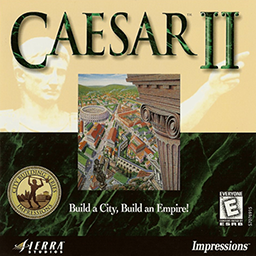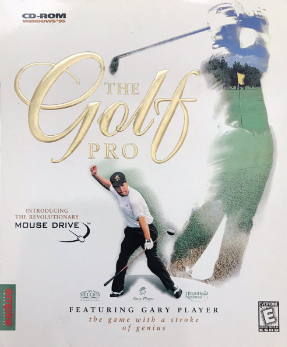
Caesar II is a 1995 video game of the Caesar video game series that takes place in Ancient Rome. It is the second game in the City Building series.

Need for Speed II is a 1997 racing video game released for PlayStation and Microsoft Windows. It is a part of the Need for Speed series and is the second installment, following The Need for Speed.

PGA Tour Golf is a golf video game and the first in the PGA Tour game series. It was developed by Sterling Silver Software and released in 1990, for MS-DOS. It was initially published by Electronic Arts, which subsequently released versions of the game for Sega Genesis and Amiga in 1991, followed by a version for the SNES in 1992. By 1994, Tengen had published versions for Sega's Master System and Game Gear consoles. PGA Tour Golf received generally positive reviews for its realism, sound, and camera. Several critics considered the computer versions to be the best golf game available at the time of its release. It was followed by PGA Tour Golf II.
EA Salt Lake was an American video game developer located in Salt Lake City, Utah, United States. It was owned by video game publisher Electronic Arts (EA).

Links 2003 is a golf video game developed by Microsoft and published by Microsoft Game Studios. It is part of the Links series and was released for Windows in 2002. It follows Links 2001 and was followed by Links 2004. The game includes six courses, a course designer, and four professional golfers: David Toms, Jesper Parnevik, Sergio García, and Annika Sörenstam. Links 2003 introduces a golf swing method that works in real time as the player makes the shot.

PGA Championship Golf 2000 is a golf simulation game for Windows. It was developed by Headgate Studios and released by Sierra Sports. It follows PGA Championship Golf 1999 Edition. An upgraded version was released in December 2000, under the title PGA Championship Golf Titanium Edition.
Front Page Sports Baseball was a series of baseball games created by Dynamix in the mid to late 1990s. It remains popular as a simulation engine for online leagues.

Actua Golf 2 is a sports video game developed and published by Gremlin Interactive for PlayStation and Microsoft Windows. Development of the game was underway as of August 1997, and it was released in September 1997 in Europe, and in June 1998 in North America. A Sega Saturn version was planned, but eventually cancelled.

Links 2001 is a golf-based sports simulation game developed by Access Software and Microsoft Games Group and published by Microsoft. It is part of the Links series and follows Links LS 2000. It is the first game in the series to include a golf course designer, allowing the player to create custom courses. It also features Arnold Palmer, Sergio García, and Annika Sörenstam as playable golfers.

Links LS 1998 is a golf video game developed and published by Access Software. It is part of the Links video game series, following Links LS (1996). It was released in 1997, and is the first game in the series to be published for Microsoft Windows. The game was well received, and was followed by Links LS 1999.

Jack Nicklaus 5 is a golf video game developed by American studio Eclipse Entertainment and published by Accolade for Windows 95. It is part of a series of golfing games named after golfer Jack Nicklaus. It was released in November 1997, shortly after its predecessor, Jack Nicklaus 4 (1997). Jack Nicklaus 5 received positive reviews for its graphics, sound, and a golf course designer feature, but the game sold poorly. It was followed by Jack Nicklaus 6: Golden Bear Challenge in 1999.

Jack Nicklaus 6: Golden Bear Challenge is a golf video game developed by Hypnos Entertainment and published by Activision for Microsoft Windows. It is part of a series of golfing games named after golfer Jack Nicklaus, and is the first in the series to feature him as a playable golfer. Producer and designer Mike Franco, who produced previous games in the series, began working on the game in November 1997, when Jack Nicklaus 5 was released.

Microsoft Golf 2001 Edition is a 2000 golf video game developed and published by Microsoft for Microsoft Windows. It is the final game in the Microsoft Golf series, and the successor to Microsoft Golf 1999 Edition. It uses the same game engine as Links LS 2000 (1999), part of Microsoft's Links series of golf games.

Links LS 2000 is a golf video game developed by Access Software and published by Microsoft. It is part of the Links series and was released in 1999 for Microsoft Windows, and in 2000 for Macintosh. It was followed by Links 2001.

Microsoft Golf 1998 Edition is a 1998 golf video game developed by American studio Friendly Software and published by Microsoft for Microsoft Windows. It is the fourth game in the Microsoft Golf series, following Microsoft Golf 3.0. The game uses a revamped design that is substantially different from its predecessors.

Microsoft Golf 1999 Edition is a golf video game developed by American studio Friendly Software and published by Microsoft for Microsoft Windows. It was released in the United States in late 1998. It is the fifth game in the Microsoft Golf series, following Microsoft Golf 1998 Edition, which was also developed by Friendly Software.

PGA Championship Golf 1999 Edition is a 1999 golf video game developed by Headgate Studios and published by Sierra Sports for Microsoft Windows. The game includes eight golf courses and a golf swing method known as TrueSwing, which uses the movement of the computer mouse to simulate a golf swing in real-time as the player makes the shot. Also included is the ReadyPlay feature, allowing golfers in a multiplayer group to play at their own pace without waiting for others to finish their turn. The game was praised for its variety, including its TrueSwing and ReadyPlay features, although its golf commentary was criticized. The game was followed by a sequel, PGA Championship Golf 2000.

The Golf Pro is a 1998 golf video game developed and published by Empire Interactive for Microsoft Windows. The game features professional golfer Gary Player, as well as two golf courses and a mouse-controlled golf swing method known as Mouse Drive. The game was generally praised for its graphics, but criticized for its limited camera angles. By early 1999, The Golf Pro 2 had been released in the United Kingdom.
Across the Rhine is a 1995 computer wargame developed by MPS Labs and published by MicroProse. The game was re-released digitally using DOSBox, supporting Windows, macOS, and Linux platforms.

Front Page Sports: Ski Racing is a 1997 video game from Dynamix. The game was later repackaged by publisher Sierra Sports as simply Ski Racing. It was followed by Skiing, 1999 Edition.

















